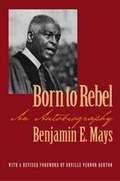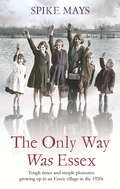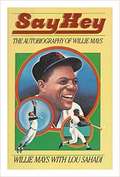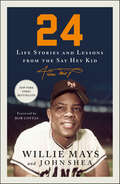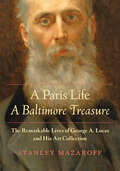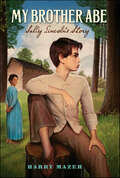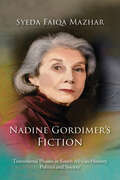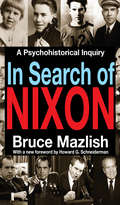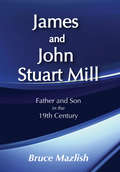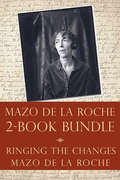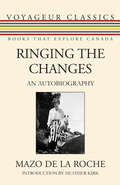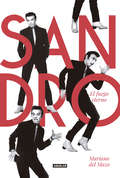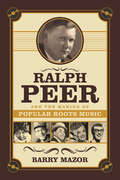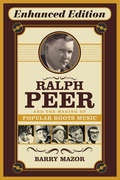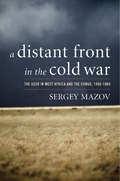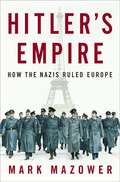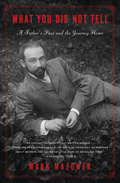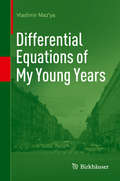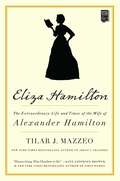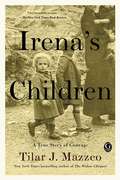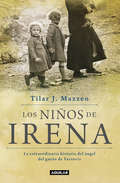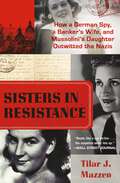- Table View
- List View
Born To Rebel: An Autobiography
by Benjamin E. MaysBorn the son of a sharecropper in 1894 near Ninety Six, South Carolina, Benjamin E. Mays went on to serve as president of Morehouse College for twenty-seven years and as the first president of the Atlanta School Board. His earliest memory, of a lynching party storming through his county, taunting but not killing his father, became for Mays an enduring image of black-white relations in the South. Born to Rebel is the moving chronicle of his life, a story that interlaces achievement with the rebuke he continually confronted.
Osceola: Memories of a Sharecropper's Daughter
by Osceola Mays Alan Govenar Shane W. EvansOsceola Mays was born in East Texas in 1909, the daughter of a sharecropper and the granddaughter of slaves. She survives fear, poverty, and the loss of loved ones by recalling memories of her childhood, and the stories, songs, and poems she learned from her mother and grandmother. Like a patchwork quilt, this collection pieces together Osceola's life into a vivid and profound mosaic. Osceola is a poignant and powerful oral history, a collection that will touch readers' hearts as it informs them of the legacy of slavery and the past conditions of African Americans in the South.
The Only Way Was Essex: growing up in an Essex village in the 1920s
by Spike MaysIn a remote corner of rural Essex, when ploughs were drawn by heavy horses and children walked shoeless to school, young Spike Mays lived with his family in a two-up, two-down cottage, where there was no electricity, no bathroom, no running water and just a shared privy in the back yard. Beset by poverty, this was an England in the shadow of the Great War. In this bittersweet memoir Mays recreates the village, its travelling parson, local poacher and even the local drunkard. And in the bustling backstairs world of the squire's house where Spike served his apprenticeship we see a more privileged side to life. This warm and nostalgic portrait of a very different Essex opens a door to a distant past.
The Only Way Was Essex: Tough Times and simple pleasures: growing up in an Essex village in the 1920s
by Spike MaysIn a remote corner of rural Essex, when ploughs were drawn by heavy horses and children walked shoeless to school, young Spike Mays lived with his family in a two-up, two-down cottage, where there was no electricity, no bathroom, no running water and just a shared privy in the back yard. Beset by poverty, this was an England in the shadow of the Great War. In this bittersweet memoir Mays recreates the village, its travelling parson, local poacher and even the local drunkard. And in the bustling backstairs world of the squire's house where Spike served his apprenticeship we see a more privileged side to life. This warm and nostalgic portrait of a very different Essex opens a door to a distant past.
Say Hey: The Autobiography of Willie Mays
by Willie Mays Lou SahadiThe legendary athlete discusses his greatest plays, his greatest teammates and opponents, his personal life, his days in the Negro Leagues, contemporary baseball, and his most bitter moment in major league baseball.
24: Life Stories and Lessons from the Say Hey Kid
by Willie Mays John SheaTHE INSTANT NEW YORK TIMES BESTSELLER ANDSAN FRANCISCO CHRONICLE BESTSELLERThe legendary Willie Mays shares the inspirations and influences responsible for guiding him on and off the field in this reflective and inspirational memoir."Even if, like me, you thought you had pretty much read and heard all there was to read and hear about Willie Mays, this warmhearted book will inform and reward you. And besides, what true baseball fan can ever get enough of Willie Mays? Say Hey! Read on and enjoy." —From the Foreword by Bob Costas “It’s because of giants like Willie that someone like me could even think about running for President.” —President Barack ObamaWidely regarded as the greatest all-around player in baseball history because of his unparalleled hitting, defense and baserunning, the beloved Willie Mays offers people of all ages his lifetime of experience meeting challenges with positivity, integrity and triumph in 24: Life Stories and Lessons from the Say Hey Kid.Presented in 24 chapters to correspond with his universally recognized uniform number, Willie’s memoir provides more than the story of his role in America’s pastime. This is the story of a man who values family and community, engages in charitable causes especially involving children and follows a philosophy that encourages hope, hard work and the fulfillment of dreams.“I was very lucky when I was a child. My family took care of me and made sure I was in early at night. I didn’t get in trouble. My father made sure that I didn’t do the wrong thing. I’ve always had a special place in my heart for children and their well-being, and John Shea and I got the idea that we should do something for the kids and the fathers and the mothers, and that’s why this book is being published. We want to reach out to all generations and backgrounds. Hopefully, these stories and lessons will inspire people in a positive way.” —Willie Mays
A Paris Life, A Baltimore Treasure: The Remarkable Lives of George A. Lucas and His Art Collection
by Stanley MazaroffThe gripping biography of a man and his passion for art.In 1857, George A. Lucas, a young Baltimorean who was fluent in French and enamored of French art, arrived in Paris. There, he established an extensive personal network of celebrated artists and art dealers, becoming the quintessential French connection for American collectors. The most remarkable thing about Lucas was not the art that he acquired for his clients (who included William and Henry Walters, the founders of the Walters Art Museum, and John Taylor Johnston, the founding president of the Metropolitan Museum of Art) but the massive collection of 18,000 paintings, drawings, sculptures, and etchings, as well as 1,500 books, journals, and other sources about French artists, that he acquired for himself. Paintings by Cabanel, Corot, and Daubigny, prints by Whistler, Manet, and Cassatt, and portfolios of information about hundreds of French artists filled his apartment and spilled into the adjacent flat of his mistress.Based primarily on Lucas’s notes and diaries, as well as thousands of other archival documents, Stanley Mazaroff’s A Paris Life, A Baltimore Treasure tells the fascinating story of how Lucas brought together the most celebrated French artists with the most prominent and wealthy American collectors of the time. It also details how, nearing the end of his life, Lucas struggled to find a future home for his collection, eventually giving it to Baltimore’s Maryland Institute. Without the means to care for the collection, the Institute loaned it to the Baltimore Museum of Art, where most of the art was placed in storage and disappeared from public view. But in 1990, when the Institute proposed to auction or otherwise sell the collection, it rose from obscurity, reached new glory as an irreplaceable cultural treasure, and became the subject of an epic battle fought in and out of court that captivated public attention and enflamed the passions of art lovers and museum officials across the nation.A Paris Life, A Baltimore Treasure is a richly illustrated portrayal of Lucas's fascinating life as an agent, connoisseur, and collector of French mid-nineteenth-century art. And, as revealed in the book, following Lucas's death, his enormous collection continued to have a vibrant life of its own, presenting new challenges to museum officials in studying, conserving, displaying, and ultimately saving the collection as an important and intrinsic part of the culture of our time.
A Paris Life, A Baltimore Treasure: The Remarkable Lives of George A. Lucas and His Art Collection
by Stanley Mazaroff“[An] elegantly written account of all facets of the life and career of George A. Lucas . . . of Belle Époque Paris and Gilded Age America.” —Inge Reist, Director Emeritus of The Frick Collection’s Center for the History of CollectingIn 1857, young Baltimorean George A. Lucas arrived in Paris, where he established an extensive personal network of celebrated artists and art dealers, becoming the quintessential French connection for American collectors. The most remarkable thing about Lucas was not the art that he acquired for his clients but the massive collection of 18,000 paintings, drawings, sculptures, and etchings, as well as 1,500 books, journals, and other sources about French artists, that he acquired for himself. Paintings by Cabanel, Corot, and Daubigny, prints by Whistler, Manet, and Cassatt, and portfolios of information about hundreds of French artists filled his apartment and spilled into the adjacent flat of his mistress.Based primarily on Lucas’s notes and diaries, as well as thousands of other archival documents, A Paris Life, A Baltimore Treasure is a richly illustrated portrayal of Lucas’s fascinating life as an agent, connoisseur, and collector of French mid-nineteenth-century art. And, as revealed in the book, following Lucas’s death, his enormous collection continued to have a vibrant life of its own, when—in 1990—Baltimore’s Maryland Institute proposed to auction or otherwise sell the collection. It rose from obscurity, reached new glory as an irreplaceable cultural treasure, and became the subject of an epic battle fought in and out of court that captivated public attention and enflamed the passions of art lovers and museum officials across the nation.“Mazaroff has thoughtfully recreated the legacy of one of America’s best documented late-nineteenth-century French art collections.” —Doreen Bolger, Director Emeritus, The Baltimore Museum of Art
My Brother Abe: Sally Lincoln's Story
by Harry MazerVirtually nothing is known about Sarah Lincoln, Abraham Lincoln's older sister. This novel follows the few known facts of the Lincoln family's early life, starting with the Lincolns' move from Kentucky to Indiana when Sarah was nine through their years living in a log cabin, the death of Sarah and Abe's mother when Sarah was eleven and Sarah's new responsibilities as woman of the cabin, culminate with the arrival of a stepmother a year later. The details of Sarah's character have been invented, but this novel provides real insight into Abraham Lincoln's childhood, as well as the role of women on the frontier.
Nadine Gordimer's Fiction: Transitional Phases in South African History, Politics and Society
by Syeda Faiqa MazharNadine Gordimer’s Fiction is a major study of the life and writings of Nadine Gordimer, a towering figure in the literary and cultural life of South Africa in the late 20th and early 21st centuries, recognised for her fiction through several prizes, most notably the 1991 Nobel Prize for Literature. It has the makings of a guide, taking the reader through the complexities in Gordimer’s life, literature, and society, backed by academic research (doctoral and postdoctoral) and informed by Dr. Mazhar’s study visit to South Africa, including a face-to-face interview with Gordimer. The reader gets a rich picture mediated by the author’s own intellectual journey from Pakistan – the country of her birth – and the United Kingdom. Dr. Mazhar maps the complexities of colonialism in South Africa and beyond in different forms, most notably in the legislated discrimination based on race/ethnicity, Apartheid (1948–1994). Covering the literary writings and political activism of Gordimer both during and after Apartheid, the book provides the reader with a detailed account of individual works of fiction, and vistas of critical thought and action that serve as their source and backdrop. Dr. Mazhar draws on the cultural theories of Homi Bhabha, especially on the notion of The Third Space, a fictional space/borderland between social and political polarisations, which allows for reflection, refinement, and re-action that is transformational and psychologically uplifting. She demonstrates that Gordimer takes her characters through such spaces, which allow for a transformational experience that leads to perspectives/realisations that were missing as a result of constraints that were externally imposed by law and tradition and interiorised as a survival mode. Dr. Mazhar concludes that Gordimer gracefully articulates her vision for a world free of complexities, which one must strive for. Although the book presents the academic analysis of Gordimer‘s fiction and the memoir as separate parts, there are organic connections between the two, which link the social ethos, political struggles, varied ideological perspectives, and ethnic and trans-ethnic identities from which Gordimer draws her subjects and their lives and depicts them through appropriate narrative techniques. Nadine Gordimer’s Fiction is a welcome addition to books on author studies, literary criticism, and South African culture and society. It offers excellent material for both academic and non-academic readers. The style of writing used in the book is clear and simple, yet powerful. This can help the reader to appreciate the enormous achievement of Gordimer, which has established her as a major literary figure in South Africa and beyond. Dr. Balasubramanyam Chandramohan PhD (Shef), FHEA, Senior Research Fellow, Institute of Commonwealth Studies, School of Advanced Study, University of London
In Search of Nixon: A Psychohistorical Inquiry
by Bruce MazlishWho was the real Richard Nixon and why did he behave the way he did? In this innovative work, a distinguished historian, trained in psychoanalysis, unravels the riddle of Nixon's singularly opaque political personality. Neither a political biography, nor a clinical psychoanalysis, at the time of its initial publication, In Search of Nixon launched a new genre of scholarship; the "psycho-historical inquiry." Mazlish offers insight into the subtle interplay between Nixon the man and Nixon the public figure.Why, for example, did Nixon have such personal difficulties in making decisions? Knowing how the young Nixon learned to cope with the problems of his childhood, what can we infer about his unpredictable decisions on Communist China, inflation, and the Supreme Court? Bruce Mazlish applies psychoanalysis to history in order to understand Nixon's behaviour, decisions, and political stance. He explains why Nixon characteristically projected personal crises onto the political arena�as, for example, in the famous Checkers speech, or in the Haynsworth-Carswell affair. And he examines why, conversely, political questions such as pacifism, abortion, and subversion had such a peculiarly personal meaning for him.
James and John Stuart Mill
by Bruce MazlishThe story of James and John Stuart Mill is one of the great dramas of the 19thcentury. In the tense yet loving struggle of this extraordinarily influential father and son, we can see the genesis of evolution of Liberal ideas-about love, sex, and women, wealth and work, authority and rebellion-which ushered in the modern age. The result of more than a decade of research and reflection, this is a study of the relationship between James Mill, the self-made utilitarian philosopher who tried (with only partial success) to shape his son in his own image. Mazlish integrates psychology and intellectual history as part of his larger and continuing effort to spur deeper understanding of the character, limitations, and possibilities of the social sciences.John Stuart Mill's rebellion against a joyless, loveless upbringing, one in strict accordance with the principles of Utilitarianism, was rooted ina powerful Oedipal struggle against his father's authority. Mazlish describes this rebellion as playing an important role in the genesis of classical nineteenth century liberalism. Behind this intellectual development were the women in Mills' life: Harriet the mother, never mentioned by her son in his autobiography, and Harriet Taylor, with whom Mill lived in a scandalous, if chaste, ménage a trois. It was this long relationship which informed his famous essay 'The Subjection of Women,' one of the most eloquent feminist statements ever written. A work of brilliant historical research and psychological insights, James and John Stuart Mill shows how the nineteenth-century struggle of fathers and sons shaped the social transformation of society.
The Mazo de la Roche Story 2-Book Bundle: Ringing the Changes / Mazo de la Roche
by Mazo De La Roche Heather KirkMazo de la Roche, author of the acclaimed Jalna series, is revealed in the writings of two luminaries on the subject: author Heather Kirk, and Mazo herself. This bundle unites Kirk’s groundbreaking biography of de la Roche with the great Canadian author’s memoirs, rereleased now after their original 1957 publication. Includes: Ringing the Changes First published in 1957, Mazo de la Roche’s last autobiography is a vivid look at her life in Ontario, and a parting shot at her critics. A rare insight into the intimate thoughts of Mazo de la Roche, and the private life she normally kept hidden. The author confesses how strongly she connected with her character Finch Whiteoak, her struggles with wanting to be a boy, and her complicated relationship with her cousin and adoptive sibling, Caroline. Mazo de la Roche After the spectacular success of her novel Jalna in 1927, Mazo de la Roche went on to the top of bestseller lists with a series of sixteen novels expanding the story of a Canadian family named the Whiteoaks, living in a house called Jalna. Her success allowed her to travel the world and live in a mansion near Windsor Castle. Mazo created unforgettable characters who come to life for her readers, but she was secretive about her own life and tried to escape the public attention her fame brought.
Ringing the Changes: An Autobiography
by Mazo De La Roche Heather Kirk Michael GnarowskiFirst published in 1957, Mazo de la Roche’s last autobiography is a vivid look at her life in Ontario, and a parting shot at her critics. Mazo de la Roche was once Canada’s best-known writer, loved by millions of readers around the world. Her Jalna series is filled with unforgettable characters who come to life for her readers, but she herself was secretive about her own life and tried to escape the public attention fame brought. In this memoir, de la Roche describes her childhood and her relationship with her cousin and life-long companion, Caroline Clement. She confesses her personal connection with her troubled character Finch Whiteoak and details her romantic struggles. Ringing the Changes is the closest view we have of Mazo de la Roche’s innermost thoughts and the private life she usually kept hidden.
Sandro. El fuego eterno
by Mariano Del MazoToda la verdad del ícono de la música y el cine argentinos, su varón más sensual y enigmático. ¿Qué singular parábola ocurrió para que un chico de un inquilinato de Valentín Alsina tuviera a los 22 años a América bajo la suela de sus zapatos? ¿Qué clase de invención es la de ese galán crepuscular que seducía en un escenario hasta conectado a tubos de oxígeno? ¿Qué tipo de epopeya encarna? ¿Qué extraño coraje tuvo para decidir someterse a un trasplante que fue, al fin, su último gesto de dignidad? ¿Cuál fue la máscara, la de Sandro o la de Roberto Sánchez? La historia de Sandro es una de las más fascinantes y genuinas de la cultura pop argentina. Atravesada de paradojas, de rock and roll y canción, de mujeres enigmáticas y pasiones inverosímiles, en la construcción de la leyenda conviven una madre postrada y el tango, Elvis y Charly, Aznavour y Moustache, milanesas a la napolitana y cordero ahumado, Bach y Radiolandia, lunfardo y castellano neutro, la bandera argentina y la bata roja. Los contrastes definen los artificios de un hechicero formidable. No llegan a revelar los misterios de un artista total. Este libro es un acercamiento a esos misterios.
Ralph Peer and the Making of Popular Roots Music
by Barry MazorThis is the first biography of Ralph Peer, the adventurous--even revolutionary--A&R man and music publisher who changed the breadth and flavor of popular music in the United States and around the world. It is the story of the life and 50-year career of the man who was crucial in discovering star musicians and establishing the genres of blues, jazz, country, gospel, and Latin music. It tracks Peer's role in such groundbreaking episodes as recording the record that sparked the blues craze, the first country recording sessions with Fiddlin' John Carson, his discovery of Jimmie Rodgers and the Carter Family at the famed Bristol Sessions, the popularizing of Latin American music during World War II, and the postwar transformation of music on the airwaves that set the stage for the dominance of R&B, country, and rock music.
Ralph Peer and the Making of Popular Roots Music (Enhanced Edition)
by Barry MazorThis enhanced e-book includes 49 of the greatest songs Ralph Peer was involved with, from groundbreaking numbers that changed the history of recorded music to revelatory obscurities, all linked to the text so that the reader can hear the music while reading about it.This is the first biography of Ralph Peer, the adventurous--even revolutionary--A&R man and music publisher who saw the universal power locked in regional roots music and tapped it, changing the breadth and flavor of popular music around the world. It is the story of the life and fifty-year career, from the age of cylinder recordings to the stereo era, of the man who pioneered the recording, marketing, and publishing of blues, jazz, country, gospel, and Latin music.The book tracks Peer's role in such breakthrough events as the recording of Mamie Smith's "Crazy Blues" (the record that sparked the blues craze), the first country recording sessions with Fiddlin' John Carson, his discovery of Jimmie Rodgers and the Carter Family at the famed Bristol sessions, the popularizing of Latin American music during World War II, and the postwar transformation of music on the airwaves that set the stage for the dominance of R&B, country, and rock 'n' roll.But this is also the story of a man from humble midwestern beginnings who went on to build the world's largest independent music publishing firm, fostering the global reach of music that had previously been specialized, localized, and marginalized. Ralph Peer redefined the ways promising songs and performers were identified, encouraged, and promoted, rethought how far regional music might travel, and changed our very notions of what pop music can be.
A Distant Front In The Cold War: The USSR In West Africa And The Congo, 1956-1964 (Cold War International History Project Series)
by Sergey MazovA Distant Front in the Cold War reveals West Africa as a significant site of Cold War conflict in the late 1950s and early 1960s. Although the region avoided the extreme tensions of the standoff in Eastern Europe or in the Cuban missile crisis, it nevertheless offers a vivid example of political, economic, and propagandistic rivalry between the U.S. and the USSR. For Africa, this was a critical period characterized by decolonization and the formation of African countries' first foreign policies. The United States and the Soviet Union both hoped to win the sympathies of the newly established states, and Sergey Mazov's book is the first account of that competition, which the Soviet Union lost, largely through ignorance of the region. Mazov presents evidence from previously inaccessible or unknown documents in Russian and U.S. archives, as well as an international sampling of recent scholarly works. The rich historical account pays particular attention to the repercussions of Soviet West African experience on future Soviet foreign policy, especially in the Third World.
Hitler's Empire: How the Nazis Ruled Europe
by Mark MazowerDrawing on an unprecedented variety of sources, Mark Mazower reveals how the Nazis designed, maintained, and ultimately lost their European empire and offers a chilling vision of the world Hitler would have made had he won the war. Germany's forces achieved, in just a few years, the astounding domination of a landmass and population larger than that of the United States. Control of this vast territory was meant to provide the basis for Germany's rise to unquestioned world power. Eastern Europe was to be the Reich's Wild West, transformed by massacre and colonial settlement. Western Europe was to provide the economic resources that would knit an authoritarian and racially cleansed continent together. But the brutality and short-sightedness of Nazi politics lost what German arms had won and brought their equally rapid downfall. Time and again, the speed of the Germans' victories caught them unprepared for the economic or psychological intricacies of running such a far-flung dominion. Politically impoverished, they had no idea how to rule the millions of people they suddenly controlled, except by bludgeon. Mazower forces us to set aside the timeworn notion that the Nazis' worldview was their own invention. Their desire for land and their racist attitudes toward Slavs and other nationalities emerged from ideas that had driven their Prussian forebears into Poland and beyond. They also drew inspiration on imperial expansion from the Americans and especially the British, whose empire they idolized. Their signal innovation was to exploit Europe's peoples and resources much as the British or French had done in India and Africa. Crushed and disheartened, many of the peoples they conquered collaborated with them to a degree that we have largely forgotten. Ultimately, the Third Reich would be beaten as much by its own hand as by the enemy. Throughout this book are fascinating, chilling glimpses of the world that might have been. Russians, Poles, and other ethnic groups would have been slaughtered or enslaved. Germans would have been settled upon now empty lands as far east as the Black Sea--the new "Greater Germany. " Europe's treasuries would have been sacked, its great cities impoverished and recast as dormitories for forced laborers when they were not deliberately demolished. As dire as all this sounds, it was merely the planned extension of what actually happened in Europe under Nazi rule as recounted in this authoritative, absorbing book.
What You Did Not Tell: A Russian Past and the Journey Home
by Mark MazowerUncovering their remarkable and moving stories, Mark Mazower recounts the sacrifices and silences that marked a generation and their descendants. It was a family which fate drove into the siege of Stalingrad, the Vilna ghetto, occupied Paris, and even into the ranks of the Wehrmacht. His British father was the lucky one, the son of Russian-Jewish emigrants who settled in London after escaping the Bolsheviks, civil war, and revolution. Max, the grandfather, had started out as a socialist and manned the barricades against Tsarist troops, never speaking a word about it afterwards. His wife Frouma came from a family ravaged by the Terror yet making their way in Soviet society despite it all. In the centenary of the Russian Revolution, What You Did Not Tell revitalizes the history of a socialism erased from memory--humanistic, impassioned, and broad-ranging in its sympathies. But it is also an exploration of the unexpected happiness that may await history's losers, of the power of friendship and the love of place that made his father at home in an England that no longer exists.
Differential Equations of My Young Years
by Vladimir Maz'YaVladimir Maz'ya (born 1937) is an outstanding mathematician who systematically made fundamental contributions to a wide array of areas in mathematical analysis and in the theory of partial differential equations. In this fascinating book he describes the first thirty years of his life. He starts with the story of his family, speaks about his childhood, high school and university years, describe his formative years as a mathematician. Behind the author's personal recollections, with his own joys, sorrows and hopes, one sees a vivid picture of the time. He speaks warmly about his friends, both outside and inside mathematics. The author describes the awakening of his passion for mathematics and his early achievements. He mentions a number of mathematicians who influenced his professional life. The book is written in a readable and inviting way sometimes with a touch of humor. It can be of interest for a very broad readership.
Eliza Hamilton: The Extraordinary Life and Times of the Wife of Alexander Hamilton
by Tilar J. MazzeoFrom the New York Times bestselling author of Irena’s Children comes a comprehensive and riveting biography of the extraordinary life and times of Eliza Hamilton, the wife of founding father Alexander Hamilton, and a powerful, unsung hero in America’s early days. Fans fell in love with Eliza Hamilton—Alexander Hamilton’s devoted wife—in Lin-Manuel Miranda’s phenomenal musical Hamilton. But they don’t know her full story. A strong pioneer woman, a loving sister, a caring mother, and in her later years, a generous philanthropist, Eliza had many sides—and this fascinating biography brings her multi-faceted personality to vivid life. Eliza Hamilton: The Extraordinary Life and Times of The Wife of Alexander Hamilton follows Eliza through her early years in New York, into the ups and downs of her married life with Alexander, beyond the aftermath of his tragic murder, and finally to her involvement in many projects that cemented her legacy as one of the unsung heroes of our nation’s early days. Featuring Mazzeo’s “impeccable research and crafting” (Library Journal), and perfect for fans of the richly detailed historical books by Ron Chernow and Erik Larson, Eliza Hamilton is the captivating account of the woman behind the famous man.
Irena's Children: The Extraordinary Story of the Woman Who Saved 2,500 Children from the Warsaw Ghetto
by Tilar J. MazzeoOne of Kirkus Reviews' Ten Most Anticipated Nonfiction Books of Fall 2016 From the New York Times bestselling author of The Widow Clicquot comes an extraordinary and gripping account of Irena Sendler--the "female Oskar Schindler"--who took staggering risks to save 2,500 children from death and deportation in Nazi-occupied Poland during World War II.In 1942, one young social worker, Irena Sendler, was granted access to the Warsaw ghetto as a public health specialist. While there, she reached out to the trapped Jewish families, going from door to door and asking the parents to trust her with their young children. She started smuggling them out of the walled district, convincing her friends and neighbors to hide them. Driven to extreme measures and with the help of a network of local tradesmen, ghetto residents, and her star-crossed lover in the Jewish resistance, Irena ultimately smuggled thousands of children past the Nazis. She made dangerous trips through the city's sewers, hid children in coffins, snuck them under overcoats at checkpoints, and slipped them through secret passages in abandoned buildings. But Irena did something even more astonishing at immense personal risk: she kept secret lists buried in bottles under an old apple tree in a friend's back garden. On them were the names and true identities of those Jewish children, recorded with the hope that their relatives could find them after the war. She could not have known that more than ninety percent of their families would perish. In Irena's Children, Tilar Mazzeo tells the incredible story of this courageous and brave woman who risked her life to save innocent children from the Holocaust--a truly heroic tale of survival, resilience, and redemption.
Los niños de Irena: La extraordinaria historia del ángel del gueto de Varsovia
by Tilar J. MazzeoEl testimonio único de la heroína del Holocausto: Irena Sendler. Irena Sendler, "el ángel del gueto de Varsovia", fue una enfermera y trabajadora social polaca que, en la Segunda Guerra Mundial, salvó a más de dos mil quinientos niños judíos condenados a ser víctimas del Holocausto. Llegó a ser candidata al Premio Nobel de la Paz, fue reconocida como Justa entre las naciones y se le otorgó la más alta distinción civil de Polonia: la Orden del Águila Blanca. Esta novela cuenta cómo llegó a convertirse en esa heroína, la historia de la joven y hermosa mujer que tuvo que hacer frente a grandes riesgos, a pesar de los cuales no dudó en poner en peligro su vida para ayudar a salvar las vidas de miles de pequeños. Muchos de aquellos niños están vivos y cuentan su parte de la historia en primera persona. El relato de Irena es una historia de valentía, pero también de un amor imposible y, por supuesto, de una época histórica tan terrible como real: la Segunda Guerra Mundial. Reseñas: "Los niños de Irena teje en una fascinante historia el relato de una ciudad devastada, la depravación nazi y el extraordinario valor físico y moral de aquellos que decidieron responder a la inhumanidad con compasión." Chaya Deitsch, autora de Here and There: Leaving Hasidism, Keeping My Family "Un relato fundamental, aunque aterrador, de la historia del Holocausto que hasta ahora era poco conocido: el de cómo miles de niños fueron rescatados del gueto de Varsovia por una mujer polaca con mucho valor y una extraordinaria calidad moral." Joseph Kanon, autor de Leaving Berlin "Mazzeo relata un rayo de esperanza en tiempos de desesperación en esta biografía conmovedora de una mujer que se negó a darse por vencida." Kirkus Reviews "Si bien esta no es la primera biografía de Irena Sendler, su concisión y legibilidad presentarán a muchos lectores a una mujer realmente valiente y notable, quien inició y encabezó "un gran esfuerzo colectivo de decencia"." Publishers Weekly
Sisters in Resistance: How a German Spy, a Banker's Wife, and Mussolini's Daughter Outwitted the Nazis
by Tilar J. MazzeoIn a tale as twisted as any spy thriller, discover how three women delivered critical evidence of Axis war crimes to Allied forces during World War II: &“A tantalizingly novelistic history lesson" (Kirkus). In 1944, news of secret diaries kept by Italy's Foreign Minister, Galeazzo Ciano, had permeated public consciousness. What wasn't reported, however, was how three women—a Fascist's daughter, a German spy, and an American banker&’s wife—risked their lives to ensure the diaries would reach the Allies, who would later use them as evidence against the Nazis at Nuremberg. In 1944, Benito Mussolini's daughter, Edda, gave Hitler and her father an ultimatum: release her husband, Galeazzo Ciano, from prison, or risk her leaking her husband's journals to the press. To avoid the peril of exposing Nazi lies, Hitler and Mussolini hunted for the diaries for months, determined to destroy them. Hilde Beetz, a German spy, was deployed to seduce Ciano to learn the diaries' location and take them from Edda. As the seducer became the seduced, Hilde converted as a double agent, joining forces with Edda to save Ciano from execution. When this failed, Edda fled to Switzerland with Hilde&’s daring assistance to keep Ciano's final wish: to see the diaries published for use by the Allies. When American spymaster Allen Dulles learned of Edda's escape, he sent in Frances De Chollet, an &“accidental&” spy, telling her to find Edda, gain her trust, and, crucially, hand the diaries over to the Americans. Together, they succeeded in preserving one of the most important documents of WWII. Drawing from in‑depth research and first-person interviews with people who witnessed these events, Mazzeo gives readers a riveting look into this little‑known moment in history and shows how, without Edda, Hilde, and Frances's involvement, certain convictions at Nuremberg would never have been possible.Includes a Reading Group Guide.
